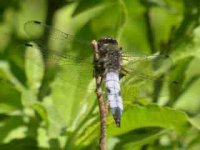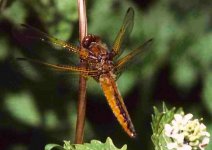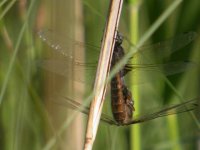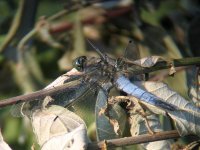-
Welcome to BirdForum, the internet's largest birding community with thousands of members from all over the world. The forums are dedicated to wild birds, birding, binoculars and equipment and all that goes with it.
Please register for an account to take part in the discussions in the forum, post your pictures in the gallery and more.
You are using an out of date browser. It may not display this or other websites correctly.
You should upgrade or use an alternative browser.
You should upgrade or use an alternative browser.
A Scarce Chaser? (1 Viewer)
- Thread starter Timhotep
- Start date
More options
Who Replied?Darrell Clegg
Well-known member
Looks like Scarce Chaser to me - the dark bases to the wings separate it from Keeled and Black-tailed Skimmer. Keeled Skimmer also has a Yellow pterostigma, and usually a blue tip to the tail. Broad-bodied chaser has yellow spots on the abdomen, which this lacks, so everything points to Scarce Chaser
Darrell
Darrell
Richard Ford
BF Member
Well done getting a new county record Tim, and a nice shot.
phyllosc
Well-known member
Scarce Chaser also behave differently from B-T Skimmers. The latter often lands on the ground and you flush them as you walk aong. Scare Chasers however, 'defend' a territory/hunt from one spot - eg. a broken reed stem - similar to Four-Spotted Chaser.
I hope this helps
Dave
I hope this helps
Dave
Steve Lister
Senior Birder, ex County Recorder, Garden Moths.

Weird this. I got a poor view of a dragonfly on the Grantham Canal yesterday which in the end I decided was a fat Black-tailed Skimmer. Now I'm thinking it could have been one of these, which would be a county first for Leics too !! Will have to go back and have another look.
Steve
Steve
Surreybirder
Ken Noble
steveinleics said:Weird this. I got a poor view of a dragonfly on the Grantham Canal yesterday which in the end I decided was a fat Black-tailed Skimmer. Now I'm thinking it could have been one of these, which would be a county first for Leics too !! Will have to go back and have another look.
Steve
Sure it wasn't a broad-bodied chaser?
Surreybirder
Ken Noble
Tim, I would agree with your ID. The other 'blue' dragonflies can be eliminated as follows:
keeled skimmer has yellow pterostigma and no dark basal markings on the wing. (and my book also shows a pale line through the dark markings which your pic also shows).
Black-tailed skimmer has black pterostigma but no dark basal markings on wings.
Broad-bodied chaser lacks the black markings at the base of the abdomen and a mature male would have noticable yellow spots down the sides of the abdomen.
So unless it's a first for the UK, I reckon you've got a first for your county (which is.....?) Edit I guess you've got a first for your county either way
BTW you can safely rule out 'waisted skimmer' (a dreadful name in my view) and 'southern skimmer' both of which I've seen in Cyprus!
keeled skimmer has yellow pterostigma and no dark basal markings on the wing. (and my book also shows a pale line through the dark markings which your pic also shows).
Black-tailed skimmer has black pterostigma but no dark basal markings on wings.
Broad-bodied chaser lacks the black markings at the base of the abdomen and a mature male would have noticable yellow spots down the sides of the abdomen.
So unless it's a first for the UK, I reckon you've got a first for your county (which is.....?) Edit I guess you've got a first for your county either way
BTW you can safely rule out 'waisted skimmer' (a dreadful name in my view) and 'southern skimmer' both of which I've seen in Cyprus!
Last edited:
steve covey
Jack of all Orders - Master of None
Definately a Scarce Chaser - and a mated one as well [due to the pruinosity being rubbed off on the abdomen, where the female has 'grabbed' him in the wheel position] My county [Wiltshire] has a good colony of them on the Bristol Avon - one of only 6 in the country [now maybe 7?] Lets hope these are the first signs of a positive increase/expansion.
Lets hope these are the first signs of a positive increase/expansion.
Steve.
Steve.
steve covey
Jack of all Orders - Master of None
PS my Avatar is my owm line drawing of a female Scarce Chaser. In life the abdomen is a luminous amber colour. I'll hunt out one of my pics and post it to the group.
Steve.
Steve.
Surreybirder
Ken Noble
I was wondering about those black marks, Steve. I gather that this is also a feature that is peculiar to scarce chaser?
steve covey
Jack of all Orders - Master of None
As far as I know Ken no other Chaser/Darter shows these marks after mating. Its a very convenient way of ascertaining how successful mating has been in a particular colony.
Female L. fulva attached as promised [I hope - I still get confused how to convert bytes to kbytes ie. 2024000 bytes = ? kbytes.:-(
Steve.
Female L. fulva attached as promised [I hope - I still get confused how to convert bytes to kbytes ie. 2024000 bytes = ? kbytes.:-(
Steve.
steve covey
Jack of all Orders - Master of None
Richard Ford
BF Member
Wow fantastic Steve, Great shot.
Thank you all!
Now, it seems clear that it is a scarce chaser. This is remarkable, because it is one of the most rare dragonflies in Finland.
Till 2002, only one constant habitat of the species was known. It is located about 60 km north-east from here. Then a great new book about dragonflies was published and after that a couple of new places has been found. The author has a great website with english summary, http://korento.net/
I purchased the book a couple of weeks ago and found two pictures of a female scarce chaser among my old slides. Naturally. I had no idea where and when I had taken those pictures (but they must be at least 10 years old), so I started searching the most possible locations and found the first scarce chasers almost immediately. After that, I´ve found two other places and seen tens of males, but only a couple of females. I also took a picture of a mating couple. It is not too good, but if you look it carefully, you can see how the female is holding its legs around male´s abdomen. I´ll post a better picture if I get one.
Now, it seems clear that it is a scarce chaser. This is remarkable, because it is one of the most rare dragonflies in Finland.
Till 2002, only one constant habitat of the species was known. It is located about 60 km north-east from here. Then a great new book about dragonflies was published and after that a couple of new places has been found. The author has a great website with english summary, http://korento.net/
I purchased the book a couple of weeks ago and found two pictures of a female scarce chaser among my old slides. Naturally. I had no idea where and when I had taken those pictures (but they must be at least 10 years old), so I started searching the most possible locations and found the first scarce chasers almost immediately. After that, I´ve found two other places and seen tens of males, but only a couple of females. I also took a picture of a mating couple. It is not too good, but if you look it carefully, you can see how the female is holding its legs around male´s abdomen. I´ll post a better picture if I get one.
Attachments
Last edited:
Surreybirder
Ken Noble
That's an exciting story, Timhotep!
The site you refer to has some superb pix. (Click on 'In English' about half way down the left-hand column in case anyone else is as slow at me as finding my way 'into' the English section.) I can understand why his book has won so many acclamations!
I wonder what you'll discover next?
The site you refer to has some superb pix. (Click on 'In English' about half way down the left-hand column in case anyone else is as slow at me as finding my way 'into' the English section.) I can understand why his book has won so many acclamations!
I wonder what you'll discover next?
Surreybirder
Ken Noble
Nice pic, Steve!
I wonder what you'll discover next?
That is exactly what I´ve been thinking! I´m very excited about this and because there are a lot of possible places in the neighbourhood to find more scarce chasers and other interesting species, I can´t wait to explore all of them!
Unfortunately, it has been cold and rainy since friday, but the weather forecast tells it´ll be sunny tomorrow!
alan_rymer
Well-known member

Can this one be I.D.ed as a Scarce Chaser too?.
Took this picture this evening ( Handheld Digiscope ), tried to get photo from an alternative angle but it flew and didn't return!.
I think it is a Scarce Chaser ( Using "Feild Guide to insects of Britain & N Europe" by Bob Gibbons !).
Can anyone confirm this I.D.?.
Took this picture this evening ( Handheld Digiscope ), tried to get photo from an alternative angle but it flew and didn't return!.
I think it is a Scarce Chaser ( Using "Feild Guide to insects of Britain & N Europe" by Bob Gibbons !).
Can anyone confirm this I.D.?.
Attachments
harry eales
Ancient Entomologist
alan_rymer said:Took this picture this evening ( Handheld Digiscope ), tried to get photo from an alternative angle but it flew and didn't return!.
I think it is a Scarce Chaser ( Using "Feild Guide to insects of Britain & N Europe" by Bob Gibbons !).
Can anyone confirm this I.D.?.
Hello Alan,
I'm sorry, but your picture seem to be of an over-mature male Black-tailed Skimmer Orthetrum cancellatum Your specimen lacks the dark basal patch that the Scarce Chaser possesses.
Harry
harry eales
Ancient Entomologist
Surreybirder said:I was wondering about those black marks, Steve. I gather that this is also a feature that is peculiar to scarce chaser?
Hello Ken,
I think you'll find that all the 'Chaser' dragonfly species with a blue pruinescence will show these mating marks. The colouring is like the 'bloom' on a grape, and rubs off after a time, especially when mating has taken place.
Harry.
Users who are viewing this thread
Total: 2 (members: 0, guests: 2)







